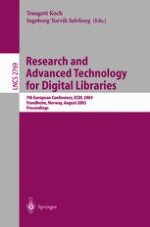2003 | OriginalPaper | Chapter
Automatic Conversion from MARC to FRBR
Authors : Christian Mönch, Trond Aalberg
Published in: Research and Advanced Technology for Digital Libraries
Publisher: Springer Berlin Heidelberg
Included in: Professional Book Archive
Activate our intelligent search to find suitable subject content or patents.
Select sections of text to find matching patents with Artificial Intelligence. powered by
Select sections of text to find additional relevant content using AI-assisted search. powered by
Catalogs have for centuries been the main tool that enabled users to search for items in a library by author, title, or subject. A catalog can be interpreted as a set of bibliographic records, where each record acts as a surrogate for a publication. Every record describes a specific publication and contains the data that is used to create the indexes of search systems and the information that is presented to the user. Bibliographic records are often captured and exchanged by the use of the MARC format. Although there are numerous ”dialects” of the MARC format in use, they are usually crafted on the same basis and are interoperable with each other —to a certain extent. The data model of a MARC-based catalog, however, is ”[...] extremely non-normalized with excessive replication of data” [1]. For instance, a literary work that exists in numerous editions and translations is likely to yield a large result set because each edition or translation is represented by an individual record, that is unrelated to other records that describe the same work.
